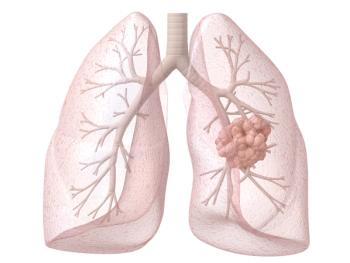
Ribociclib Plus Fulvestrant Continued to Improve OS in Advanced, HR+ Breast Cancer, Regardless of Setting
Ribociclib (Kisqali) plus fulvestrant (Faslodex) maintained significantly improved overall survival (OS) rates after nearly 5 years of follow-up compared to fulvestrant alone in postmenopausal patients who had hormone receptor (HR)-postivie, HER2-negative advanced breast cancer.
The combination of ribociclib (Kisqali) plus fulvestrant (Faslodex) maintained significantly improved overall survival (OS) rates after nearly 5 years of follow-up compared to fulvestrant alone in postmenopausal patients who had hormone receptor (HR)-postivie, HER2-negative advanced breast cancer. The benefit was seen regardless of whether the regimen was administered in the first- or second-line setting, according to data from the phase 3 MONALEESA-3 trial (NCT02422615).1
The results, which were presented during the 2021 ASCO Annual Meeting, showed that at a median follow-up of 56.3 months, the median OS achieved with ribociclib/fulvestrant was 53.7 months vs 41.5 months with fulvestrant alone (HR, 0.726; 95% CI, 0.588-0.897) in the overall study population.
Among those who received treatment in the first- and second-line setting, a larger magnitude of benefit was achieved with the addition of ribociclib to fulvestrant over fulvestrant alone. In the first-line subgroup, the median OS had not yet been reached in the investigative arm vs 51.8 months with fulvestrant alone (HR, 0.640; 95% CI, 0.464-0.883). In the second-line subgroup, the median OS was 39.7 months vs 33.7 months, respectively (HR, 0.780; 95% CI, 0.587-1.037).
“This is an exploratory analysis with extended follow-up of just under 5 years. Again, we saw that the ribociclib/fulvestrant arm maintained its OS advantage in this postmenopausal population,” Dennis J. Slamon, MD, PhD, lead study author and director of Clinical/Translational Research at UCLA Health, said during a presentation on the data. “MONALEESA-3 remains the only randomized trial that evaluated a CDK4/6 inhibitor and demonstrated a significant OS advantage in patients in the first-line setting.”
In MONALEESA-3, investigators examined ribociclib plus fulvestrant in postmenopausal patients with HR-positive/HER2-negative advanced breast cancer.2,3 Patients had received up to 1 line of prior endocrine treatment for advanced disease; they could not have previously received chemotherapy.
Patients were randomized 2:1 to receive ribociclib at 600 mg/day for a 3-weeks-on/1-week-off schedule (n = 485); or a matching placebo (n = 242). Both treatment arms received fulvestrant at 500 mg on day 1 of each 28-day cycle, with an additional dose on day 15 of cycle 1. Patients were stratified by presence or absence of liver or lung metastases prior to endocrine therapy.
The primary end point of the trial was progression-free survival (PFS) per local radiological assessment, while key secondary end points included OS, objective response rate, clinical benefit rate, time to response, duration of response, safety and tolerability, and health-related quality of life.
Prior results from the final protocol-specified OS analysis had not been reached with ribociclib/fulvestrant vs 40.0 months with fulvestrant alone (HR, 0.72; 95% CI, 0.57-0.92; P = .00455).3 At the meeting, data from an exploratory update of OS with longer follow-up were reported.
In terms of patient disposition, the treatment arms were well balanced, according to Slamon. The majority of patients who underwent randomization, or 99.7% (n = 724), received treatment. At a data cutoff of October 30, 2020, treatment was ongoing in 14.0% (n = 68) of those in the ribociclib/fulvestrant arm and 8.7% (n = 21) of those in the fulvestrant-alone arm.
The most common reason for stopping treatment across the arms was disease progression, which occurred in 61.8% (n = 299) and 79.8% (n = 193) of those on the investigative and control arms, respectively.
Additional data from the exploratory analysis showed that the 4-year OS rates in the investigative and control arms were 53.6% and 44.5%, respectively. At 5 years, the OS rates were 46.0% and 31.1%, respectively. “You can see a difference of essentially close to 9% at 4 years,” Slamon said. “By 5 years, that difference has grown, and been projected to be close to 15% [between the arms].”
Almost all patient subgroups evaluated in the trial were found to derive benefit from the CDK4/6 inhibitor, including difficult-to-treat subsets like patients with liver or lung metastases (HR, 0.73; 95% CI, 0.55-0.98), those with 3 or more metastatic sites (HR, 0.74; 95% CI, 0.53-1.04), and those with endocrine resistance (HR, 0.82; 95% CI, 0.45-1.47).
In the updated analysis, investigators examined OS based on endocrine sensitivity. “In MONALEESA-3, patients were defined to be endocrine resistant if they experienced progressive disease within the first 6 months of first-line endocrine therapy for advanced disease or while on endocrine therapy, or if they had relapsed within the first 2 years of neoadjuvant or adjuvant therapy,” Slamon explained.
Among patients who were endocrine resistant, the median OS with ribociclib/fulvestrant was 35.6 months (n = 53) vs 31.7 months with fulvestrant alone (n = 25; HR, 0.815; 95% CI, 0.451-1.473). In patients who had endocrine sensitivity, the median OS in the investigative (n = 289) and control (n = 140) arms were 49.0 months and 41.6 months, respectively (HR, 0.731; 95% CI, 0.557-0.959). “This was a 7-month improvement,” Slamon noted.
Investigators also examined time to first chemotherapy in patients enrolled to the study. Data from the updated analysis showed that the addition of the CDK4/6 inhibitor to fulvestrant led to a nearly 20-month delay in first subsequent chemotherapy use over fulvestrant alone. The number of months to first subsequent chemotherapy was 48.1 months vs 28.8 months in the investigative and control arms, respectively (HR, 0.704; 95% CI, 0.566-0.876).
Moreover, chemotherapy-free survival was about 10 months longer in the ribociclib arm vs the fulvestrant-alone arm, at 32.3 months and 22.4 months, respectively (HR, 0.688; 95% CI, 0.570-0.830).
“We also looked at PFS2, which is a measure of the survival after patients come off study, indicating that the effect may be long lasting even after the patient is off the drug,” Slamon said. “The PFS2 difference [was] in favor of ribociclib.”
The PFS2 was 37.4 months in the ribociclib/fulvestrant arm vs 28.1 months in the fulvestrant-alone arm (HR, 0.693; 95% CI, 0.570-0.844); this benefit was observed irrespective of treatment setting but was particularly notable in the frontline setting (HR, 0.63; 95% CI, 0.47-0.84).
Lastly, 81.9% of patients in the investigative arm went on to receive subsequent antineoplastic therapy vs 86.4% of those in the control arm, with 14.0% and 30.0% of patients, respectively, receiving a CDK4/6 inhibitor as any subsequent line of treatment.
“Obviously, chemotherapy was among the most frequent [therapy] that was given,” Slamon noted. “Hormone therapy alone was also [frequently administered]. Patients in the control arm were more likely to receive a CDK4/6 inhibitor after coming off study than those on the experimental arm.”
Safety data proved to be consistent with what had previously been reported in earlier analyses of MONALEESA-3. The most frequently experienced toxicities in the experimental arm were neutropenia (72.0%, all-grade; 50.7%, grade 3; 7.5%, grade 4), leukopenia (32.5%, all-grade; 16.4%, grade 3; 0.6%, grade 4), anemia (20.1%, all-grade; 3.9%, grade 3), and thrombocytopenia (9.3%, all-grade; 1.0%, grade 3; 0.2%, grade 4).
“No new safety signals were detected with a follow-up of more than 4 and a half years in this study,” Slamon concluded.
References
1. Slamon DJ, Neven P, Chia SKL, et al. Updated overall survival (OS) results from the phase III MONALEESA-3 trial of postmenopausal patients (pts) with HR+/HER2- advanced breast cancer (ABC) treated with fulvestrant (FUL) +/- ribociclib (RIB). J Clin Oncol. 2021;39(suppl 15):1001. doi:10.1200/JCO.2021.39.15_suppl.1001
2. Slamon DJ, Neven P, Chia S, et al. Phase III randomized study of ribociclib and fulvestrant in hormone receptor–positive, human epidermal growth factor receptor 2–negative advanced breast cancer: MONALEESA-3. J Clin Oncol. 2018;36(24):2465-2472. doi:10.1200/JCO.2018.78.9909
3. Slamon DJ, Neven P, Chia S, et al. Overall survival with ribociclib plus fulvestrant in advanced breast cancer. N Engl J Med. 2020;382(6):514-524. doi:10.1056/NEJMoa1911149
Newsletter
Stay up to date on recent advances in the multidisciplinary approach to cancer.


















































































